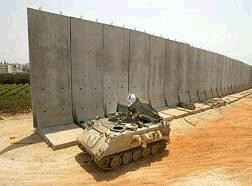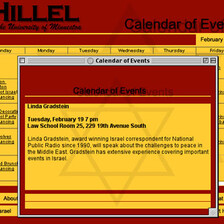The Electronic Intifada 28 July 2003
To: National Public Radio (wesun@npr.org, ombudsman@npr.org)
From: Ali Abunimah
Date: 27 July 2003
Dear NPR News,
I have often complained that as far as your “reporter” Linda Gradstein is concerned, the Middle East is a fact-free zone. By this, I mean that she represents many key issues as simply matters of interpretation and perspective (‘Palestinians say the sky is blue, but Israeli spokesmen insist it is Leprechaun green with lavender polka dots.’)
But this morning’s performance by Gradstein was almost as ridiculous as my little joke above. When speaking on Weekend Edition Sunday about the thing that Israel is building through the West Bank to physically divide the land and annex vast swathes of the occupied territories to Israel, Gradstein said that Israel calls it a “fence” while Palestinians call it “the wall, with echoes of the Berlin wall.”
Can it really be impossible for Linda to actually find out if it is a fence or a wall and tell us precisely and unequivocally?
First, some definitions. This is how the American Heritage English Dictionary defines “fence”:
fence (n.)1. A structure serving as an enclosure, a barrier, or a boundary, usually made of posts or stakes joined together by boards, wire, or rails.
2. The art or sport of fencing.
3. (a) One who receives and sells stolen goods.
(b) A place where stolen goods are received and sold.
4. Archaic: A means of defense; a protection.
And this is how it defines “wall”:
wall (n.)1. An upright structure of masonry, wood, plaster, or other building
material serving to enclose, divide, or protect an area, especially a
vertical construction forming an inner partition or exterior siding of a
building.2. A continuous structure of masonry or other material forming a rampart
and built for defensive purposes. Often used in the plural.3. A structure of stonework, cement, or other material built to retain a
flow of water.4. (a) Something resembling a wall in appearance, function, or
construction, as the exterior surface of a body organ or part: the
abdominal wall.(b) Something resembling a wall in impenetrability or strength: a wall
of silence; a wall of fog.(c) An extreme or desperate condition or position, such as defeat or
ruin: driven to the wall by poverty.5. Sports. The vertical surface of an ocean wave in surfing.
Now let’s look at some pictures of the edifice in question:
http://www.palestinemonitor.org/Special%20Section/Closure/Separation_wall_cover.htm

The image of the APC from palestinemonitor.org
The wall (yes, Linda, it is, after all, a wall) is eight metres high. It is higher than the Berlin wall ever was.
This is what Israeli journalist Amira Hass wrote in Haaretz on 16 July:
“Israelis still use the convenient and misleading term “fence” to describe the system of fortifications that is currently being erected on Palestinian lands in the West Bank. Even “wall,” the term more commonly used in foreign-language reports, is insufficient to describe what is really being built at this very moment: A concrete wall eight meters high, wire fences and electronic sensors, ditches four meters deep on either side, a dirt path to reveal footprints, an area into which entry is forbidden, a two-lane road for army patrols, and watchtowers and firing posts every 200 meters along the entire length. These are the components of the ‘fence.’ “
So when is Linda going to stop playing games with language and with the truth and actually commit herself to the facts?
Yours,
Ali Abunimah
http://electronicIntifada.net




